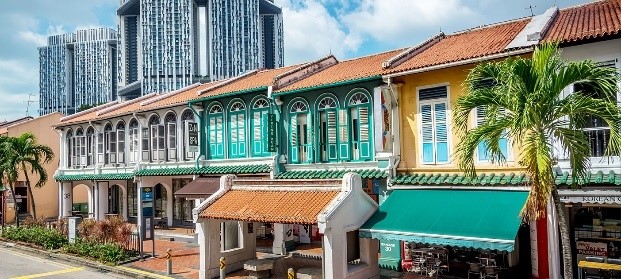An overview of the S-Reit landscape
![]()
If you’ve only got a minute:
- S-Reits are popular among retail investors as they offer attractive dividend yields compared to government bonds and fixed deposits.
- S-Reits can invest in property ranging from single sectors (commercial, healthcare, hospitality, industrial and retail) to a combination of them.
- There has been a trend towards S-Reits merging to achieve a more well-rounded portfolio.
![]()
Singapore has often been labelled a property-obsessed country, with real estate being a major contributor to growth in household wealth over time.
Investing in property has its merits. As a tool for wealth accumulation and legacy planning, it worked well for past generations, with returns on residential property consistently outpacing inflation.
Today, however, it is a less viable option for younger Singaporeans as property prices have been steadily rising in recent years, outpacing wage growth. The government even stepped in with further rounds of residential property cooling measures in December 2021, September 2022 and April 2023.
Such measures make the purchase of a second residential property as an investment, less attainable or attractive for most age groups here.
That said, investing in Real Estate Investment Trusts (Reits) is one way for retail investors to gain exposure to property or diversify to other property segments without the hassle and high costs of personally owning physical properties.
Read more: What you need to know about Reits
An Overview
Since Singapore-listed Reits (S-Reits) were first listed on the Singapore Exchange (SGX) in 2002, they have steadily grown in popularity among retail investors. There are some key reasons for this.
S-Reits are required to distribute 90% of income earned as dividends to unitholders. This is an attractive proposition for those in favour of “income investing”. Distributions to unitholders, which are quarterly or semi-annual, are exempt from tax too.
As of 11 May 2023, the average dividend yield of S-Reits is 8.7%1 – an attractive return over the STI, government bonds and term deposits. Traditionally, the asset class has averaged yields of between 5% and 6%. Historically, Reits have also performed well in a rising interest rate environment.
The barriers to entry for investing in Reits are often low too, and individuals are able to purchase S-Reits on stock exchanges through brokers like DBS Vickers.
If the unit price of a particular S-Reit is $2, 1 lot (i.e. 100 units) will require an investment of $200 excluding brokerage fees and tax. This means you can start investing in a portfolio of income-generating real estate assets without having to fork out a large amount of funds and take up a property loan.
Read more: Practical ways to invest in Reits
Find out more about: DBS Vickers Online Trading Account
There are 42 S-Reits and property trusts listed on the Singapore Exchange as of 11 May 20231, making up a market capitalisation of $101 billion that represents 12% of the overall Singapore stock market.
More than 90% of S-Reits and property trusts hold overseas properties in their portfolios.
7 S-Reits are constituents of the Straits Times Index (STI), the highest ever for the asset class.

Siblings of Reits
Property trusts and stapled trusts are siblings of Reits and there are 8 of them listed in Singapore. They typically invest in shopping malls, residential properties, offices, industrial facilities, hospitality, and healthcare properties.
Property Trusts
The primary difference between Reits and property trusts is that the latter is not required to pay out 90% of income as dividends to unitholders. As this distribution requirement is applied to taxable income, Reits enjoy tax transparency treatment by IRAS (subject to other conditions) that property trusts do not.
Property trusts are not subject to the same debt requirements or asset size limits that Reits must adhere to. Property trusts also do not enjoy the same tax incentives that Reits do.
Stapled Trusts
These are financial instruments that bundle 2 or more securities with different legal structures together to be traded as one. This can include Reits, property trusts and even property stocks. Only the Reit component of a stapled trust is required to meet Reit listing requirements.
The 5 property sectors
The type of properties held by Reits, property trusts and stapled trusts can be split into 5 broad categories.
1. Commercial
These consist mostly of office buildings regardless of where they are located (i.e. in the central business district or in suburban areas).
They include: Elite Commercial Reit, IReit Global, Keppel Pacific Oak US Reit, Keppel Reit, Manulife US Reit and Prime US Reit.
2. Healthcare
Trusts that fall into this space own hospitals, specialist medical centres and nursing homes.
They include: First Reit and Parkway Life Reit.
3. Hospitality
These are Reits with portfolios that consist of hotels, serviced residences and in some cases even theme parks.
They include: ARA US Hospitality Trust, CapitaLand Ascott Trust, CDL Hospitality Trusts, Far East Hospitality Trust and Frasers Hospitality Trust.
4. Industrial
Trusts that focus on this sector include warehouses, logistics processing facilities, and more recently, data centres and e-commerce facilities, as key components of their portfolio.
They include: AIMS APAC Reit, CapitaLand Ascendas Reit, Daiwa House Logistics Trust, Digital Core Reit, EC World Reit, ESR-Logos Reit, Keppel DC Reit, Mapletree Industrial Trust, Mapletree Logistics Trust and Sabana Industrial Reit.
5. Retail
Properties included in a retail portfolio include shopping malls (both urban and suburban) and outlet malls.
They include: BHG Retail Reit, Dasin Retail Trust, Frasers Centrepoint Trust, Lippo Malls Indonesia Retail Trust, Paragon Reit, Sasseur Reit, Starhill Global Reit and United Hampshire US Reit.

Diversified Reits
S-Reits are not restricted to holding just 1 of the 5 categories of property. Diversified Reits hold a mixture of property types, and specialised Reits own properties that do not fit within the other Reit sectors.
These have a portfolio containing more than 1 type of property or other real estate assets.
Many S-Reits, including some of the larger ones, have a diversified portfolio as this helps to cushion any industry-specific market downturns.
For example, during Covid-19 many retail properties were negatively affected. A diversified Reit would have been less severely impacted as compared to one that held solely retail properties during this period.
Reits with commercial and retail properties
They include: CapitaLand Integrated Commercial Trust, Lendlease Global Commercial Reit and Suntec Reit.
Reits with commercial, retail, and industrial properties
They include: CapitaLand China Trust, CapitaLand India Trust and Cromwell European Reit.
Reits with commercial and industrial properties
They include: Frasers Logistics & Commercial Trust.
Reits with commercial, hospitality and retail properties
They include: Mapletree Pan Asia Commercial Trust and OUE Commercial Reit.
Reit mergers
In recent years, there has been a trend towards Reits merging with the view of either having a greater depth of properties within a particular real estate sector, and/or a more well-rounded portfolio.
An example of the former is the 2018 merger of ESR-Reit and Viva Industrial Trust, which resulted in Singapore’s 4th largest industrial Reit.
Meanwhile, CapitaLand Commercial Trust and CapitaLand Mall Trust merged to form CapitaLand Integrated Commercial Trust (CICT) in November 2020. Following the merger, CICT is now the largest S-Reit by market capitalisation (around $13.5 billion as at 11 May 2023)1, offering investors exposure to both commercial and retail properties.
More recently on 23 May 2022, Mapletree Commercial Trust and Mapletree North Asia Commercial Trust merged to form Mapletree Pan Asia Commercial Trust (MPACT), the 3rd largest S-Reit by market capitalisation (around $9.2 billion as at 11 May 2023)1.
The merging of Reits to form a larger portfolio come with its own set of pros and cons.
Read more: How to evaluate and analyse Reits
Ready to start?
Speak to the Wealth Planning Manager today for a financial health check and how you can better plan your finances.
Need help selecting an investment? Try ‘Make Your Money Work Harder’ on DBS NAV Planner to receive specific investment picks based on your objectives, risk profile and preferences.
Sources:
1 SGX Research, “Chartbook: SREITs & Property Trusts”, 11 May 2023. Accessed 16 May 2023.
Disclaimers and Important Notice
This article is meant for information only and should not be relied upon as financial advice. Before making any decision to buy, sell or hold any investment or insurance product, you should seek advice from a financial adviser regarding its suitability.
All investments come with risks and you can lose money on your investment. Invest only if you understand and can monitor your investment. Diversify your investments and avoid investing a large portion of your money in a single product issuer.
Disclaimer for Investment and Life Insurance Products








That's great to hear. Anything you'd like to add? (Optional)
We’re sorry to hear that. How can we do better? (Optional)